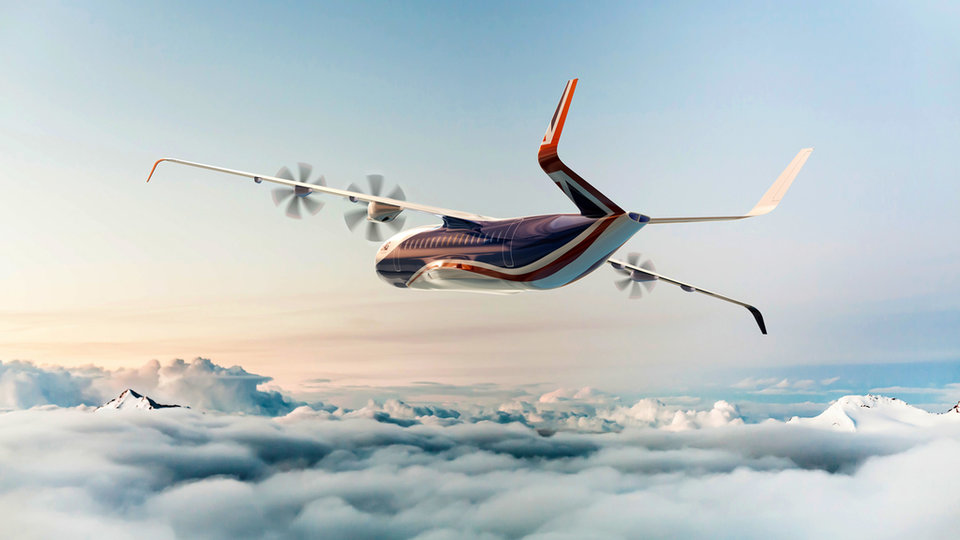Q&A | ENVIRONMENT
Will the HERA herald a surge of hybrid electric aircraft?
UK firm Electric Aviation Group has unveiled the design for the world’s first hybrid electric 70+ seater regional aircraft, set to become operational in 2028. Ilaria Grasso Macola speaks to CEO Kamran Iqbal to find out why he believes the aircraft will become “a blueprint” for the wider industry on the path towards decarbonisation.
The aviation sector’s contribution to global carbon emissions is widely known and the need to decarbonise is one of the hottest topics in the industry. According to data published by the Air Transport Action Group, the aviation industry produces 2% of the world’s human-induced CO2 emissions, accounting for 915 million tonnes of CO2 in 2019 alone.
While many in the industry believe that sustainable aviation fuels are the best way forward, some companies, such as Bristol-based development firm Electric Aviation Group (EAG), are looking at a more hybrid approach.
The company recently made the headlines for being the first to design a hybrid 70+ seater regional aircraft, going against the trend of building small electric and hybrid electric planes.
EAG CEO Kamran Iqbal explains why he has decided to ‘go bigger’ and why his aircraft programme will move past hybrid to contribute to the complete decarbonisation of aviation.
Kamran Iqbal, founder and CEO of Electric Aviation Group (EAG)

All Images: EAG
Ilaria Grasso Macola: When and why was EAG founded?
Kamran Iqbal: After being in the aerospace sector for almost 17 years – predominantly working for Airbus on several Airbus aircraft programmes – I founded EAG back in 2017.
[The idea was] to develop the world's first 70+ seater aircraft programme, which we launched at the Farnborough Connect international air show, receiving an overwhelming response from the aerospace sector, investors and the international media.
Why did you decide to develop the Hybrid Electric Regional Aircraft (HERA)?
Like many others, we started looking at urban air mobility, which was the flavour of the day back in 2017, when everybody was developing a two to four-seater urban air mobility aircraft programme.
I soon realised that none of these platforms were going to solve the decarbonisation and massive transportation issues, and none of the airline operators would be running these small aircraft for commercial operations.
We decided to take a step back and ask ourselves what actual aircraft size we could develop and deliver within this decade, based upon near-term and available technology.

A visualisation of the Hybrid Electric Regional Aircraft (HERA).
What innovative features will HERA have?
The key technology highlights in terms of our programme are whisper-quiet take-off and landing performance, which will enable 24/7 operations.
During the day, airlines can use our aircraft for passenger operations, while at night our planes can be reverted for cargo operations by sliding the seat pallet [out] and replacing it with cargo ones. This system gives airlines the chance to enhance the utilisation of the airframe, increasing their revenues as a result of the aircraft's enhanced utilisation.
Our planes will also be endowed with [a] battery-neutral operational potential recovery system, which enables battery regeneration and recharging, so when one of our aircraft lands it is already fully charged.
This will allow a very quick turnaround time and no charging infrastructure, giving our planes access to the majority of runways around the world.
How ‘hybrid’ will HERA be?
We have designed the aircraft to eventually become fully sustainable and all-electric as battery technology improves. Today, the biggest challenge we have is that we do not have the battery technology to have even a 40-seater all-electric aircraft.
So part of the mission will focus purely on the battery and part of the mission will focus on [using] sustainable aviation fuels, which will have next to neutral carbon emissions.
Using sustainable aviation fuels together with batteries is going to be extremely beneficial for the environment. If we only used the battery on our aircraft, we could reduce between 30% and 40% carbon and NOx emissions, but given that we will adopt sustainable aviation fuels, our planes will be net-zero when they enter into service in 2028.

You say the programme is expected to create several thousand jobs and unlock billions in investment. How will this happen?
To deliver the HERA programme within this decade, we have set up the Jet Zero Consortium, which consists of key players in the global aerospace sector as well as universities, airlines and governments in Europe and North America.
In terms of funding, we are trying to explore a private-public sector partnership and we are in talks with governments [in countries] such as the UK and Canada, as well as the European, North American and Middle Eastern private sectors.
How much of an impact will HERA have on the decarbonisation of the aviation industry?
Everybody's talking about decarbonisation, but are they producing an aircraft that will enable us to deliver those decarbonisation targets, such as reducing carbon and NOx emissions by 75% and 90% respectively by 2050?
If we want to achieve these targets we have to start developing hybrid electric planes today, as the aeroplane development cycle time is ten years. By 2030, we have to get aeroplanes, which emit less carbon and less NOx and produce less noise in the air, rather than just talking and not doing much about it.
When it enters into service, our HERA will be a blueprint, a step in the right direction. We have also taken future-proofing into our design concept from day one, so when new technologies become available, we can retrofit our HERA to make it more sustainable.
Which UN Sustainable Development goals will HERA comply with?
Out of the 17 UN Sustainable Development Goals, our project will comply with nine of them, including Industry Innovation and Infrastructure, Life above Land and Decent Work and Economic Growth.
As for Industry Innovation and Infrastructure, if our planes can land at smaller regional airports, they will effectively use that infrastructure which is currently not utilised.
When you talk about the reduction of carbon and NOx, we'll comply to Life above Land by reducing NOx, CO2 and noise emissions. As for Decent Work and Economic Growth, this $5bn investment into the aerospace sector will create more than 45,000 jobs in the UK ecosystem.
This will have a positive impact on the labour market and the economy, especially in the current climate where the global aerospace sector is on its knees.

Is hybrid the solution for the decarbonisation problem going forward?
Hybrid is the stepping stone, and a very important one. Our HERA is initially hybrid but will be turned into [a] fully sustainable [aircraft] as the technology grows and evolves.
Some of the big players in the aviation sector, such as Airbus or Boeing, are moving in the direction of decarbonisation, but they are moving very slowly.
In our case, we are saying that the technology is already present today to deliver HERA within this decade. If we want to address these environmental challenges and achieve 2050 targets, we need to move much faster.